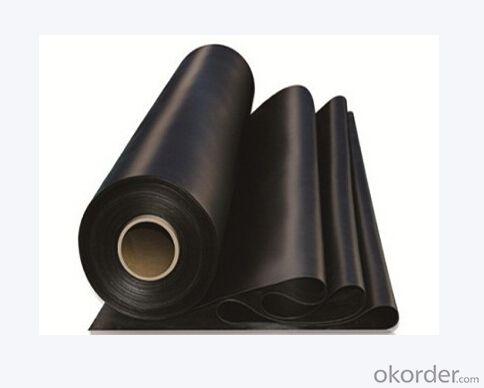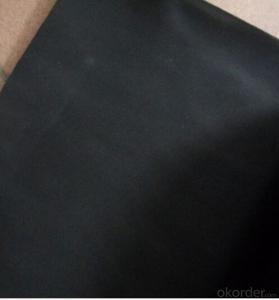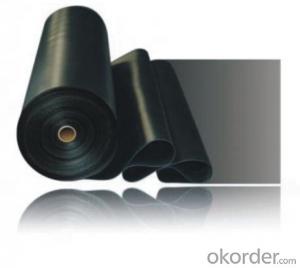EPDM Waterproofing Membrane Factory Price
- Loading Port:
- Qingdao
- Payment Terms:
- TT OR LC
- Min Order Qty:
- 2000 m²
- Supply Capability:
- 100000 m²/month
OKorder Service Pledge
OKorder Financial Service
You Might Also Like
EPDM waterproofing Rubber membrane
1. Introduction of EPDM Waterproofing Membrane:
EPDM Waterproofing Membrane is the modified materials which is widely used at home and abroad in the kinds of roofs, tunnel, basement such sorts of constructions' waterproofing.
They are based upon EPDM rubber with modifier, softener and accelerant assistants added to provide flexibility and stability . Through the precise ingredients, mixing, extrusion, rolling, curing processes to made of modified EPDM Waterproofing material with high strength and high flexibility.
2. Specification of EPDM Waterproofing Membrane:
Type | EPDM Waterproof Membrane | ||
Material | EPDM Rubber | ||
Thickness | 1.2mm | 1.5mm | 2.0mm |
Weight(kg/m2) | 1.54-1.58 | 1.79-1.83 | 2.25-2.29 |
Size | 1.2m(width) * 20m(length)/roll | ||
Type | Vulcanized & Weldable | ||
Pattern | Non-reinforced(homogeneous) | ||
Packing | 24sqm/roll, with plastic bag | ||
Color | Black | ||
Application | Roof, basement, pond, Lake, steel structure roof, swimming pool, underground, tunnel, etc | ||
3. Product Features of EPDM Waterproofing Membrane:
1. Great tensile strength,long-range elasticity and aging resistant.
2. Excellent heat reisistant and can be used under -70°C~~+110°C .
3.Good anti-corrosion, ultraviolet resistant, root penetration resistance
4.Long life use over 50 years and used longer 100 years or more under the condition of buried in the ground.
5.Light and easy to install.
4. Application of EPDM Waterproofing Membrane:
(1) Roofs, Basement, Toilets
(2) Industrial and civil building waterproofing
(3) Geosynthetic liner for swimming pool, channels, irrigation system
(4) Especially suitable for projects with high requirements in durability, anti-corrosion and deformation

4. Some photos:



- Q:Are waterproofing membranes suitable for bridge abutments?
- Bridge abutments, the structures supporting the ends of a bridge, can benefit from the use of waterproofing membranes. Given their exposure to moisture and water, it is crucial to protect these structures. Waterproofing membranes serve as an effective barrier against water and moisture intrusion, making them an excellent solution for bridge abutments. These membranes, typically composed of materials like bitumen, PVC, or EPDM, possess high resistance to water penetration. Moreover, they offer additional protection against factors such as UV rays, chemicals, and temperature changes. By installing waterproofing membranes on bridge abutments, the risk of water damage, deterioration, and corrosion can be significantly reduced. Consequently, the bridge structure's durability and longevity are enhanced.
- Q:Are waterproofing membranes resistant to alkali exposure?
- Waterproofing membranes, as a rule, show resistance to alkali exposure. Their purpose is to create a shield against water and other damaging substances, including alkalis. These membranes are crafted from materials like rubber, bitumen, or polymer-based compounds that possess a strong resistance to alkali. This guarantees the membrane's durability and effectiveness, even when confronted with alkali-rich surroundings, such as concrete or cement surfaces. Furthermore, these membranes undergo thorough testing and are manufactured specifically to endure alkali exposure, rendering them a dependable choice for waterproofing needs in diverse industries, including construction and infrastructure.
- Q:Can a waterproofing membrane be used for a tunnel?
- Yes, a waterproofing membrane can be used for a tunnel. Waterproofing membranes are commonly used in tunnel construction to prevent water infiltration and protect the tunnel structure from potential damage caused by water. These membranes act as a barrier, preventing the passage of water and ensuring the tunnel remains dry and structurally sound.
- Q:Can a waterproofing membrane be used on wood block surfaces?
- Yes, a waterproofing membrane can be used on wood block surfaces. Wood block surfaces, such as decks or wooden floors, can benefit from the application of a waterproofing membrane to protect against water damage and extend the lifespan of the wood. Waterproofing membranes create a barrier that prevents water from seeping into the wood, which can cause rot, warping, or decay over time. By applying a waterproofing membrane, the wood block surface can be effectively protected and maintained, ensuring its durability and longevity. However, it is important to choose a waterproofing membrane that is specifically designed for wood surfaces and follow the manufacturer's instructions for application to ensure the best results.
- Q:Can a waterproofing membrane be used for planter boxes and green roofs?
- Yes, a waterproofing membrane can be used for planter boxes and green roofs. The membrane prevents water leakage and provides a protective barrier for the underlying structure, ensuring that the planter boxes and green roofs remain waterproof and durable.
- Q:Can a waterproofing membrane be used in roofs?
- Yes, a waterproofing membrane can be used in roofs. In fact, it is a commonly used method for protecting roofs from water damage. A waterproofing membrane is typically made of a durable material, such as rubber or modified bitumen, and is applied to the roof surface to create a barrier against water penetration. This membrane acts as a protective layer that prevents water from seeping into the underlying structure of the roof, thus preventing leaks and potential damage. Waterproofing membranes are especially useful for flat or low-sloped roofs, where water can easily accumulate and cause problems. Additionally, these membranes can be applied to various types of roofing materials, including concrete, metal, and asphalt, making them versatile and suitable for different roof types. Overall, using a waterproofing membrane in roofs is an effective way to enhance their durability and longevity, while also providing reliable protection against water infiltration.
- Q:Can waterproofing membranes be used in wet areas like bathrooms?
- Yes, waterproofing membranes can indeed be used in wet areas like bathrooms. In fact, it is highly recommended to use waterproofing membranes in bathroom areas to prevent water damage and leakage. These membranes are specifically designed to create a barrier against moisture, ensuring that water does not seep through the walls, floors, or other surfaces of the bathroom. By applying a waterproofing membrane, you can effectively protect the underlying structure from water damage, mold growth, and other issues caused by prolonged exposure to moisture. This is especially important in wet areas like bathrooms where water is constantly present. Waterproofing membranes are available in various forms such as sheet membranes, liquid membranes, and even pre-formed shower trays. They can be applied to walls, floors, shower enclosures, and other surfaces to create a watertight seal. It is crucial to properly install and maintain the waterproofing membrane as per manufacturer guidelines to ensure its effectiveness and longevity. Therefore, if you are considering renovating or building a bathroom, using waterproofing membranes is highly recommended to ensure a durable and moisture-resistant space.
- Q:How to distinguish the degree of sbs waterproofing membrane?
- Method 2: send the laboratory to do low-temperature flexible test. With the eyes and hand pull and other methods can not judge, if the experienced SBS production technology staff, from the hand pull, bending and other methods to determine the initial performance.
- Q:Can a waterproofing membrane be applied to curved or irregular surfaces?
- Indeed, it is possible to apply a waterproofing membrane to surfaces that are curved or irregular. In the market, there exist flexible waterproofing membranes that have the ability to adapt to different shapes and contours. These membranes have been designed to be stretchable, allowing for manipulation in order to perfectly fit curved or irregular surfaces while still maintaining their excellent waterproofing properties. It is crucial to select a membrane that is explicitly designed for these types of applications and to adhere to correct installation techniques to guarantee a secure and watertight seal.
- Q:What is the difference between a self-adhesive and torch-applied waterproofing membrane?
- A self-adhesive waterproofing membrane is a type of membrane that has an adhesive backing, allowing it to be easily stuck onto the surface it is being applied to. It is typically made of a flexible material, such as modified bitumen or rubberized asphalt, and is commonly used for applications such as roofs, balconies, or foundations. The adhesive backing ensures a strong and secure bond, even in challenging weather conditions. On the other hand, a torch-applied waterproofing membrane requires the use of a torch or heat gun to melt the underside of the membrane and adhere it to the surface. This type of membrane is often made of modified bitumen, which softens and becomes adhesive when heated. The heat creates a strong bond between the membrane and the substrate, providing excellent waterproofing protection. The main difference between these two types of waterproofing membranes lies in the way they are installed. Self-adhesive membranes offer a simpler and quicker installation process, as they can be directly applied to the surface without the need for any additional tools or equipment. They are also considered to be a safer option, as they eliminate the potential hazards associated with using an open flame. Torch-applied membranes, on the other hand, require the use of a torch or heat gun, which adds an extra step to the installation process. This method requires skilled labor and proper training to ensure the membrane is correctly melted and adhered to the surface. However, torch-applied membranes are often preferred in situations where a superior bond is required, such as on roofs with a steep slope or in areas with heavy foot traffic. In summary, the main difference between self-adhesive and torch-applied waterproofing membranes lies in the method of installation. Self-adhesive membranes offer simplicity and safety, while torch-applied membranes provide a stronger bond and are often used in more challenging or specific applications. The choice between the two ultimately depends on the specific requirements and conditions of the project.
1. Manufacturer Overview |
|
|---|---|
| Location | |
| Year Established | |
| Annual Output Value | |
| Main Markets | |
| Company Certifications | |
2. Manufacturer Certificates |
|
|---|---|
| a) Certification Name | |
| Range | |
| Reference | |
| Validity Period | |
3. Manufacturer Capability |
|
|---|---|
| a)Trade Capacity | |
| Nearest Port | |
| Export Percentage | |
| No.of Employees in Trade Department | |
| Language Spoken: | |
| b)Factory Information | |
| Factory Size: | |
| No. of Production Lines | |
| Contract Manufacturing | |
| Product Price Range | |
Send your message to us
EPDM Waterproofing Membrane Factory Price
- Loading Port:
- Qingdao
- Payment Terms:
- TT OR LC
- Min Order Qty:
- 2000 m²
- Supply Capability:
- 100000 m²/month
OKorder Service Pledge
OKorder Financial Service
Similar products
New products
Hot products
Hot Searches
Related keywords





























